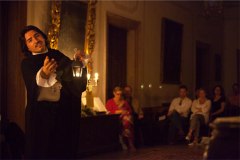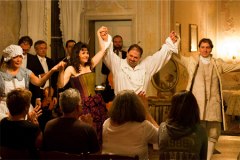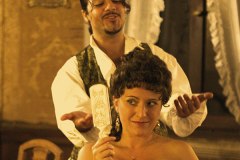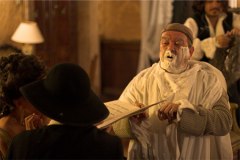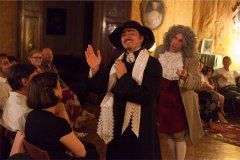The Barber of Seville Venice Chamber Opera Tickets
Mo | Tu | We | Th | Fr | Sa | Su |
Il Barbiere di Siviglia (The Barber of Seville) is an opera by Gioacchino Rossini, with its libretto by Cesare Sterbini, based on a play with the same name by PierreAugustin Caron de Beaumarchais. The opera is set in the 17th century and therefore the halls of Palazzo Barbarigo Minotto are the ideal setting, embellished and complemented by its magnificent Baroque furnishings.
The two acts are performed in three different halls: the Portego (the central hall), Tiepolo Hall and the bedroom with an alcove; during the interval, it is possible to appreciate the splendour of the halls facing the Grand Canal. The palace architecture, with its countless doors in high-quality wood, allows the artists to move around an “all-round” stage space so that the audience can fully participate in Rossini’s most amusing opera.
The interiors environments are candlelit and the elegant costumes, designed by Anthony Knight, are inspired by period clothes and made of the finest fabrics.
The exhilarating direction combined with the vocal and instrumental virtuosity of the performers will guarantee the spectators a vibrant, cheerful evening.
Synopsis
Place: Seville, Spain
Time: 17th century
Act 1
The square in front of Bartolo's house
In a public square outside Bartolo's house a band of musicians and a poor student named Lindoro are serenading, to no avail, the window of Rosina ("Ecco, ridente in cielo"; "There, laughing in the sky"). Lindoro, who is really the young Count Almaviva in disguise, hopes to make the beautiful Rosina love him for himself – not his money. Almaviva pays off the musicians who then depart, leaving him to brood alone. Rosina is the young ward of the grumpy, elderly Bartolo and she is allowed very little freedom because Bartolo plans to marry her once she is of age and thus appropriate her considerable dowry.
Figaro approaches singing (Aria: "Largo al factotum della città"; "Make way for the factotum of the city"). Since Figaro used to be a servant of the Count, the Count asks him for assistance in helping him meet Rosina, offering him money should he be successful in arranging this (duet: "All'idea di quel metallo"; "At the idea of that metal"). Figaro advises the Count to disguise himself as a drunken soldier, ordered to be billeted with Bartolo, so as to gain entrance to the house. For this suggestion, Figaro is richly rewarded.
A room in Bartolo's house with four doors
The scene begins with Rosina's cavatina, "Una voce poco fa" ("A voice a little while ago"). (This aria was originally written in the key of E major, but it is sometimes transposed a semitone up into F major for coloratura sopranos to perform, giving them the chance to sing extra, almost traditional, cadenzas, sometimes reaching high Ds or even Fs.)
Knowing the Count only as Lindoro, Rosina writes to him because she is interested in getting to know him better. As she is leaving the room, Bartolo enters with the music teacher Basilio. Bartolo is suspicious of the Count, and Basilio advises that he be put out of the way by creating false rumours about him (this aria, "La calunnia è un venticello" – "Calumny is a little breeze" – is almost always sung a tone lower than the original D major).
When the two have gone, Rosina and Figaro enter. Figaro asks Rosina to write a few encouraging words to Lindoro, which she has actually already written. (Duet: "Dunque io son...tu non m'inganni?"; "Then I'm the one...you're not fooling me?"). Although surprised by Bartolo, Rosina manages to fool him, but he remains suspicious. (Aria: "A un dottor della mia sorte"; "To a doctor of my class").
Count Almaviva, disguised as a soldier and pretending to be drunk, enters the house and demands to be quartered there. In fear of the drunken man, Berta the housekeeper rushes to Bartolo for protection. Bartolo tells the "soldier" that he (Bartolo) has an official exemption which excuses him from the requirement to quarter soldiers in his home. Almaviva pretends to be too drunk and belligerent to understand, and dares Bartolo to brawl. While Bartolo searches his cluttered desk for the official document which would prove his exemption, Almaviva whispers to Rosina that he is Lindoro in disguise, and passes a love-letter to her. Bartolo suspiciously demands to know what is in the piece of paper in Rosina's hands, but she fools him by handing over her laundry list. Bartolo and the Count argue loudly. Basilio enters; then Figaro, who warns that the noise of the argument is rousing the whole neighborhood. Finally, the noise attracts the attention of the Officer of the Watch and his troops, who crowd into the room. Bartolo demands that the Officer arrest the "drunken soldier". The Officer starts to do so, but Almaviva quietly reveals his true identity to the Officer, and he (the Officer) backs off. Bartolo and Basilio are astonished and mystified; Figaro laughs quietly at them. (Finale: "Fredda ed immobile, come una statua"; "Cold and still, just like a statue"). The confusion intensifies and causes everyone to suffer headaches and auditory hallucinations ("Mi par d'esser con la testa in un'orrida fucina; dell'incudini sonore l'importuno strepitar"; "My head seems to be in a fiery forge: the sound of the anvils deafens the ear").
Act 2
A room in Bartolo's house with a piano
Count Almaviva again appears at the doctor's house, this time disguised as Don Alonso, a priest and singing tutor who is substituting for the supposedly ailing Basilio. To gain Bartolo's trust, Don Alonso tells him he has intercepted a note from Lindoro to Rosina, and says that Lindoro is a servant of Count Almaviva who has dishonorable intentions towards Rosina. While Almaviva pretends to give Rosina her singing lesson ("Contro un cor"; "Against a heart"), Figaro arrives to shave Bartolo. Not wanting to leave Rosina alone with the singing teacher, Bartolo insists Figaro shave him right there in the music room. Basilio suddenly appears for his scheduled music lesson, but he is bribed by a full purse from Almaviva and persuaded to leave again, with much discussion of how ill he looks. (Quintet: "Don Basilio! – Cosa veggo!"; "Don Basilio! – What do I see?"). Bartolo overhears the lovers conspiring, and angrily drives everybody away. Berta vents about the crazy household ("Il vecchiotto cerca moglie").
A room in Bartolo's house with a grille looking out onto the square.
Bartolo orders Basilio to have the notary ready to marry him to Rosina that evening. Basilio leaves and Rosina arrives. Bartolo shows Rosina the letter she wrote to "Lindoro" and persuades her that this is proof that Lindoro is merely a flunky of Almaviva and is toying with her at Almaviva's behest. Rosina believes the story and agrees to marry Bartolo.
During an instrumental interlude, the music creates a thunder storm to indicate the passage of time. Almaviva and Figaro climb up a ladder to the balcony and enter Rosina's room through a window. Rosina accuses Almaviva, whom she believes to be Lindoro, of betraying her. Almaviva reveals his identity and the two reconcile. While Almaviva and Rosina are enraptured by one another, Figaro keeps urging them to leave. Two people are heard approaching the front door. They are Basilio and the notary. The Count, Rosina, and Figaro attempt to leave by way of the ladder, but discover it has been removed. Using bribes and threats, Almaviva coerces the notary into marrying him to Rosina, with Basilio and Figaro as the legally required witnesses. Bartolo barges in, accompanied by the Officer and the men of the watch, but too late; the marriage is already complete. The befuddled Bartolo is pacified by being allowed to retain Rosina's dowry. The opera concludes with an anthem to love ("Amor e fede eterna, si vegga in noi regnar!"; "May love and faith eternally be seen to reign in us").
Program and cast
Palazzo Barbarigo Minotto
Musica a Palazzo offers a new way of experiencing the grand Opera
The Opera is a travelling show and each act is set in a different hall of one of the most fascinating Venetian palaces: Palazzo Barbarigo Minotto.
THE ASSOCIATION DIMENSIONE LIRICA
Dimensione Lirica is a cultural association founded in 2009, and since 2020 assumed Musica a Palazzo format in order to make Palazzo Barbarigo Minotto a place where to meet, experiment and to gather in order to spread and broaden the knowledge of Opera culture.
This is how the Musica a Palazzo ensemble conceives the ‘Chamber Opera’: the traditional setting of Opera in the theatre is replaced by a stage that fits in perfectly with the scenery: every act of the opera takes place in a different hall of the palace, the magnificent baroque furnishings of which are a natural complement to the set design.
The originality of the direction is represented by the interaction between the singers, the instrumentalists and the audience, breaking down any kind of barrier between them, giving the viewer the thrill of experiencing the Opera from within.
This feeling is enhanced by the skilful use of all-round stage space.
Following a tour throughout the United States, Musica a Palazzo, has staged La Traviata for the 41th international Brighton Festival (UK) held at the Royal Pavilion, where it has proved to be a huge success with both the audience and the critics, by winning the Press Award (The Argus Angel Award) as the best production of the Festival. Recently it has also staged The Barber of Seville at the Potsdam Music Festival in Germany.
Location
Palazzo Barbarigo Minotto
Overlooking the Grand Canal, historical evidence proves that the construction of this noble Venetian palace dates back to around the 15th century.
It consists of three halls facing the Grand Canal and just as many on the Rio Zaguri; during the first half of the 18th century, this palace was embellished by the work of artists whose fame and talent are still acknowledged today.
The painters Giambattista Tiepolo, Francesco Fontebasso, Jerome Mingozzi and the stucco worker Carpoforo Mazzetti, also known as Tencalla were commissioned by nobleman Pietro Barbarigo, the works of whom are perfectly preserved and are still appreciated by scholars and art lovers.
The palace houses a 17th century aristocratic family chapel, with Louis XIV style elm flooring, inlaid with olive and other fine wood. The doors are also in the Louis XIV style with walnut wood panels and decorated with vine leaf-shaped bronze handles, while the flooring is a blend of terrazzo, Venetian “pastellone” pavings.
For further information on the history of Palazzo Barbarigo Minotto, please visit the page on Wikipedia Musica_a_Palazzo
Articles of association
In order to attend any activity of the association, including evening performances, it is necessary to be officially registered as a member. After filling out the application form, the new member will be given a membership card.
Following this link, you can read or download the articles of association which regulate Musica a Palazzo activities.
Donations
The association does not receive any public funding or sponsorship. Every year, Dimensione Lirica dedicates itself to the restoration and maintenance of the main floor in Palazzo Barbarigo Minotto, the costs of which are very high in a city like Venice.
Therefore, we will be extremely grateful to those who wish to make contributions to support the association.
More about the venue/theater:
The Palazzo Barbarigo Minotto (also called Palazzo Minotto Barbarigo) is a 15th-century palace on the Grand Canal in Venice, northern Italy, next to the much larger Palazzo Corner.[1] Built in the Venetian Gothic style, it was originally two palaces, Palazzo Barbarigo and Palazzo Minotto, later joined together. The Barbarigo palace was owned by the Barbarigo family for several centuries and was the birthplace of Gregorio Barbarigo, who once refused the Papal Crown.[2] It was later owned by the Minotto and Martinengo families.
The facade of Palazzo Barbarigo-Minotto on the Grand Canal of Venice.
Three staterooms face the Grand Canal and another three face Rio Zaguri. In the first half of the 18th century frescoes and paintings by Giovanni Battista Tiepolo, Francesco Fontebasso and Carpoforo Tencalla were commissioned by Pietro Barbarigo. Its chapel has Louis XIV Style elm flooring inlaid with olive-root marquetry. The palace's doors, are in the same style, banded in walnut with bronze handles shaped as vine leaves. The floors of the staterooms are a blend of terrazzo paving and Venetian "pastellone" paving.
The palace is actually formed by two different buildings, merged in the 17th century. The ancient part, a 1400s Venetian-Gothic architecture featuring 12th century Byzantine friezes, was originally known as Palazzo Minotto; the newer part, Palazzo Barbarigo, was built in the 17th century.
 EN
EN DE
DE IT
IT FR
FR ES
ES RU
RU JP
JP RO
RO
